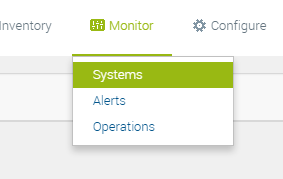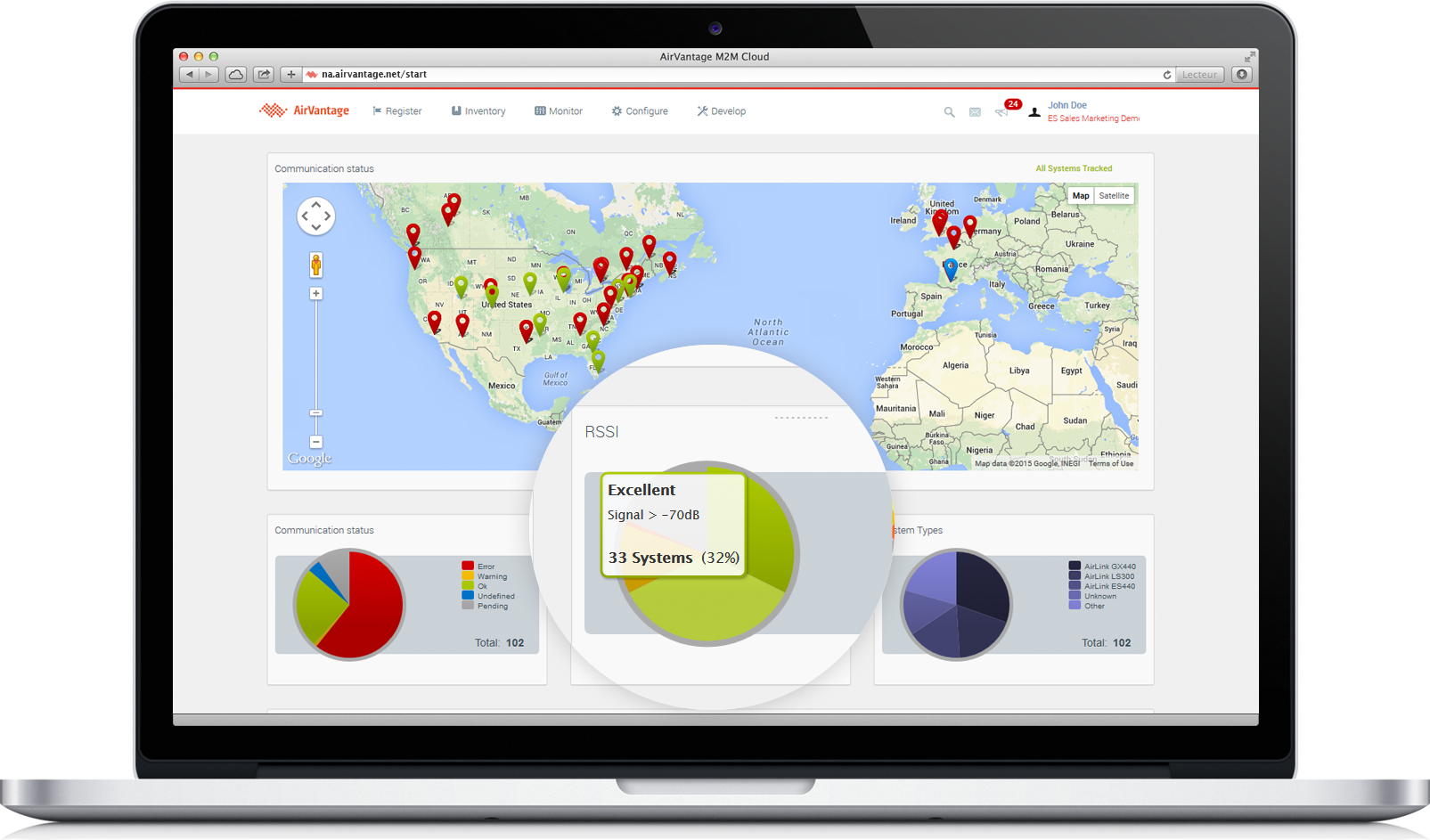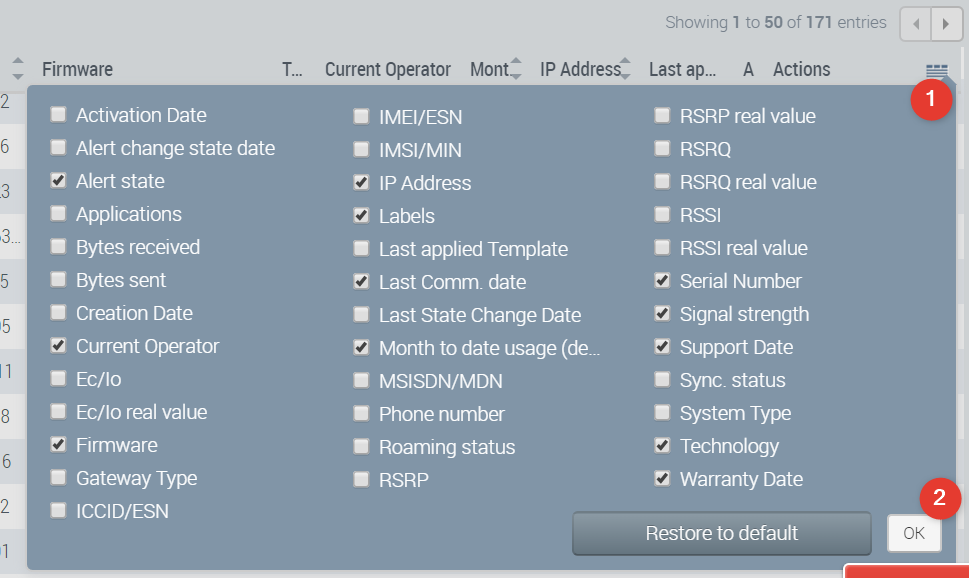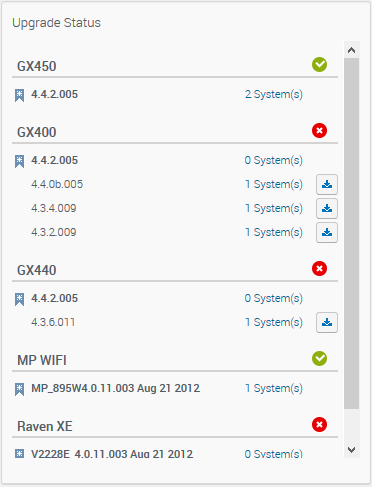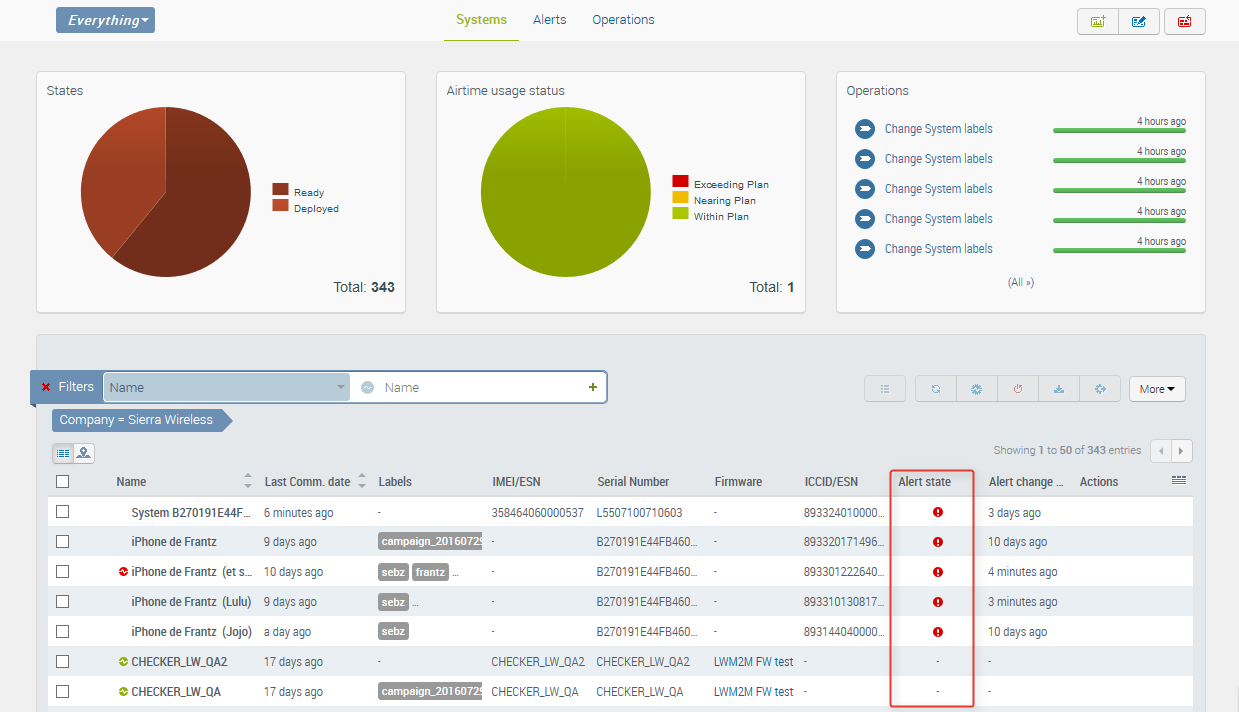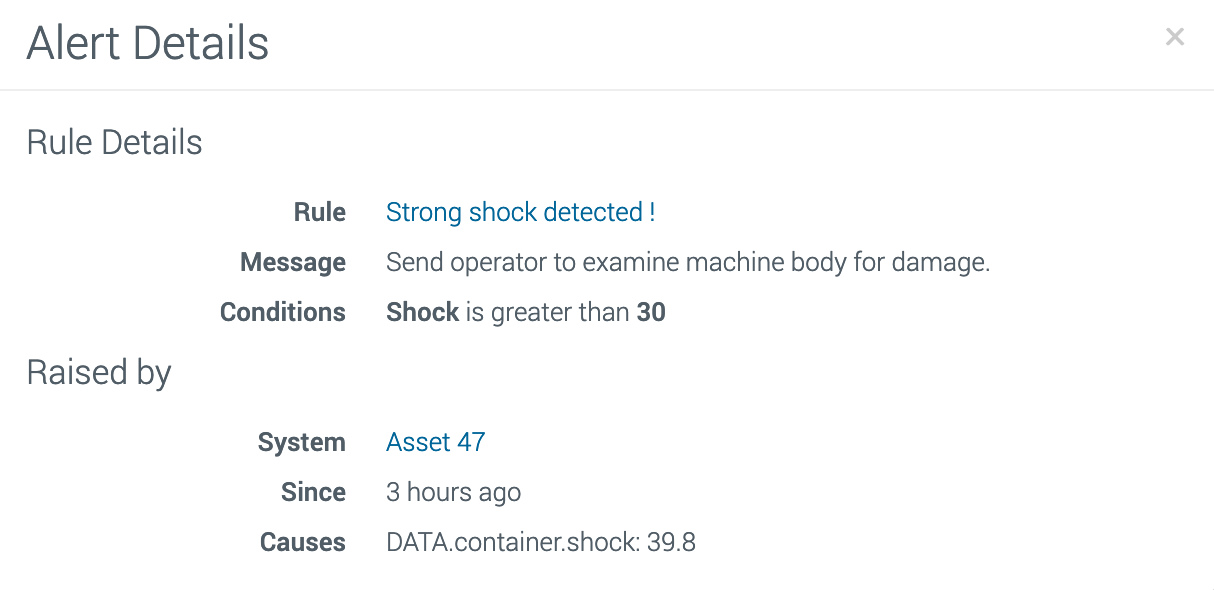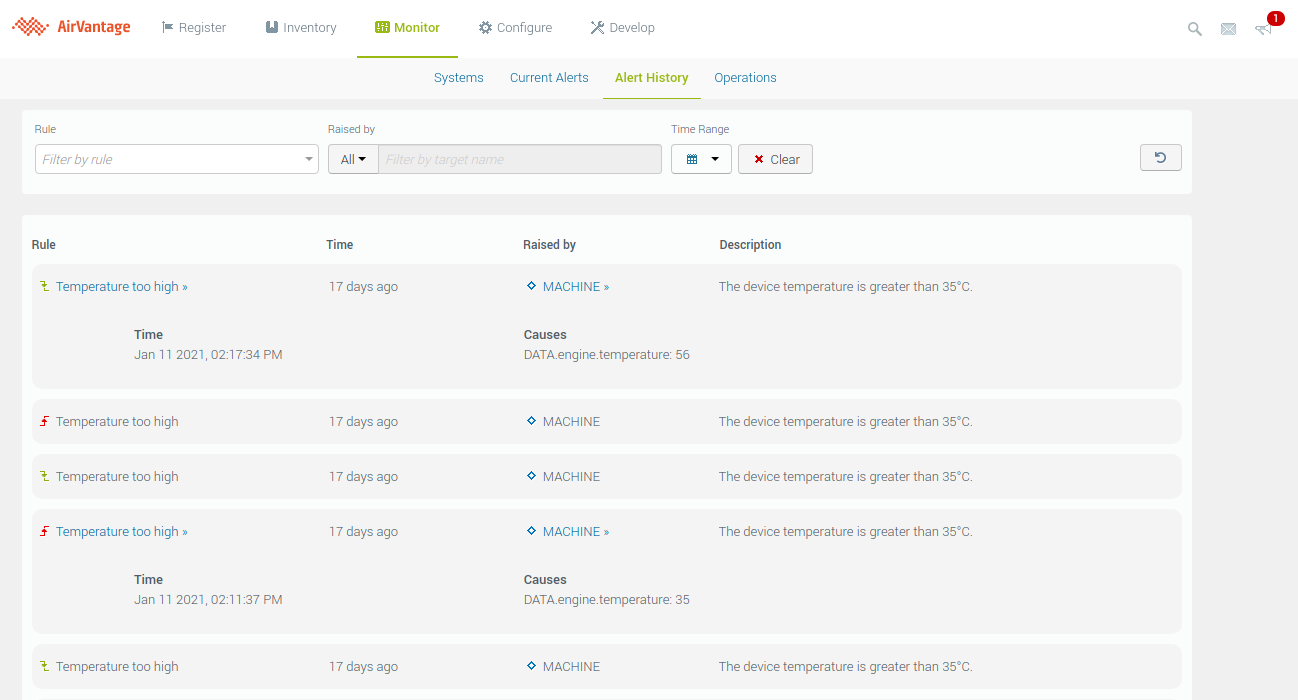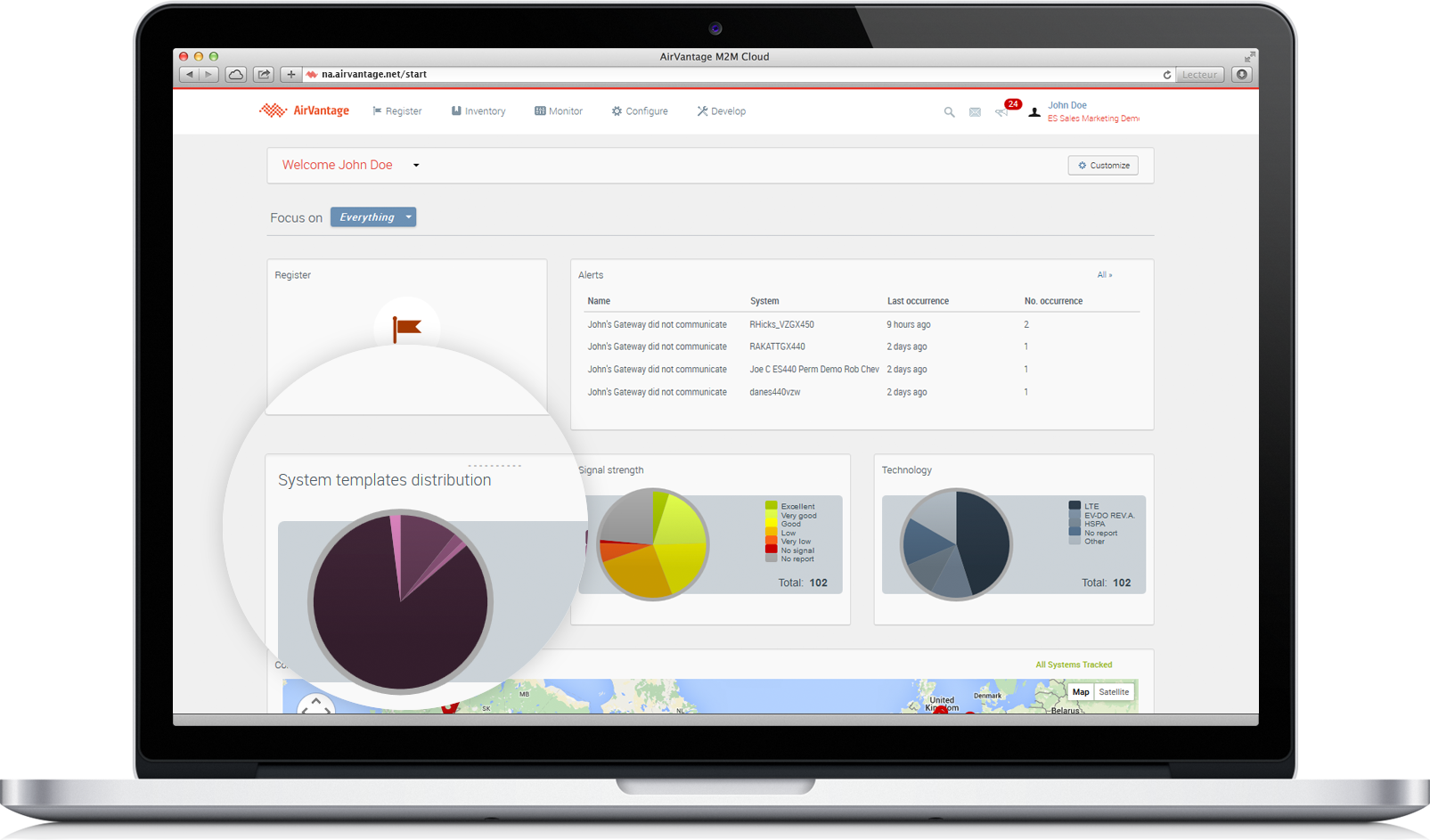Monitor
Monitor helps you manage your fleet of systems deployed on the field. It provides access to all the systems of the company along with their status, communication history, configuration and management. This page is also customizable to present the information that is most important to you.
 Initializing Table Of Contents...
Initializing Table Of Contents...All the functionalities provided by AirVantage may not be available on all the devices.
Dashboard
Configurable interactive dashboard
- The Dashboard is user configurable so you can get a quick look at the information that is most important. Online status, alerts or cellular network related information for example.
- The widgets are interactive so by clicking on a pie chart segment you will be taken directly to a list of those devices.
Birds-Eye View
- Includes a map showing the location of devices reporting GPS or configured to show fixed location via user input.
- Widgets can be configured to plot evolution of collected data, providing additional analytical capability for your fleet.
- Any numeric data can be visualized for checking the fleet trend.
- e.g. See the mean max and min values for the power input voltage of my fleet of devices.
See here for more information about dashboard.
The Monitor activity is divided in three sections:
- The Systems section. It provides access to all systems along with their status, communications history, configuration and management.
- The Alerts section shows all the alerts currently raised for your devices.
- An overview of all Operations launched on systems (see How to use Operations? for more information)
List View
The Systems section shows all the systems READY and DEPLOYED in your company along with the device management data. You can find the description of the systems states in the Inventory section.
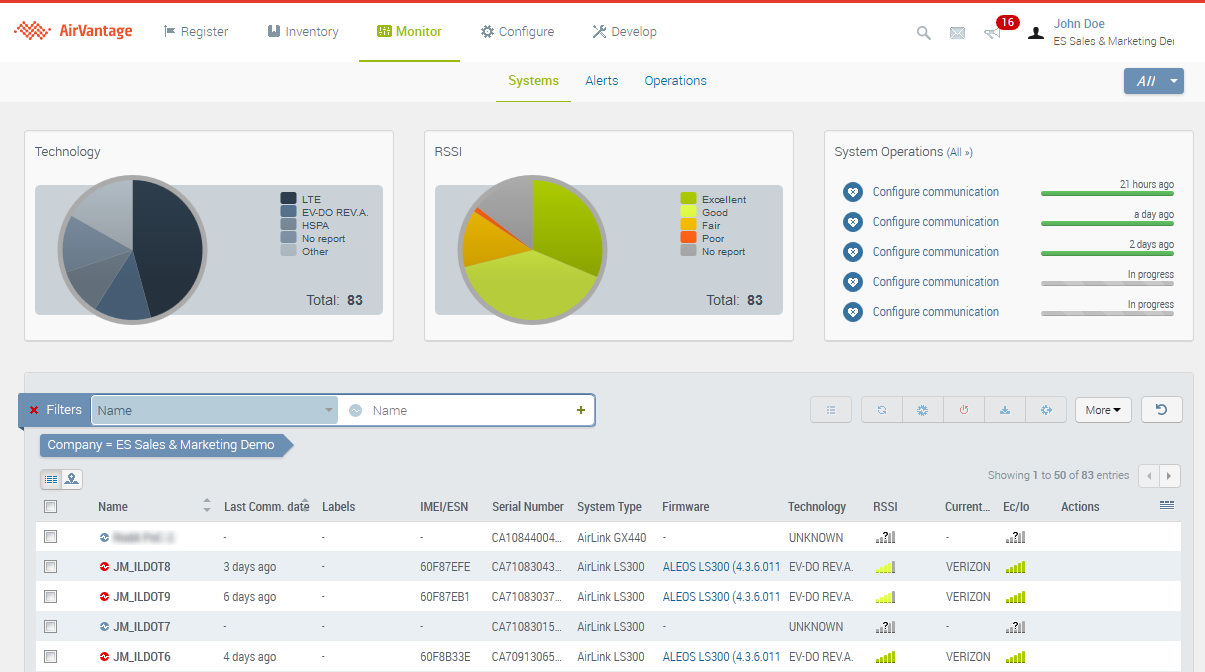
Manage large deployments
- Finding a device or group of devices of interest is easy using filters. These can be applied for single or multiple variables: filter on gateway type + firmware version.
- Labels gives a powerful way to add flexibility in identifying devices. They can be used for geographic regions, vehicle types, host device types, application groups, or any other identifier that you would like to apply and use as a search term in the future. Devices can have an unlimited number of labels.
- The result of the filtered list is displayed in multiple pages if needed. You can select all the list with the check box displayed at the top left of the list.
See simple example below:
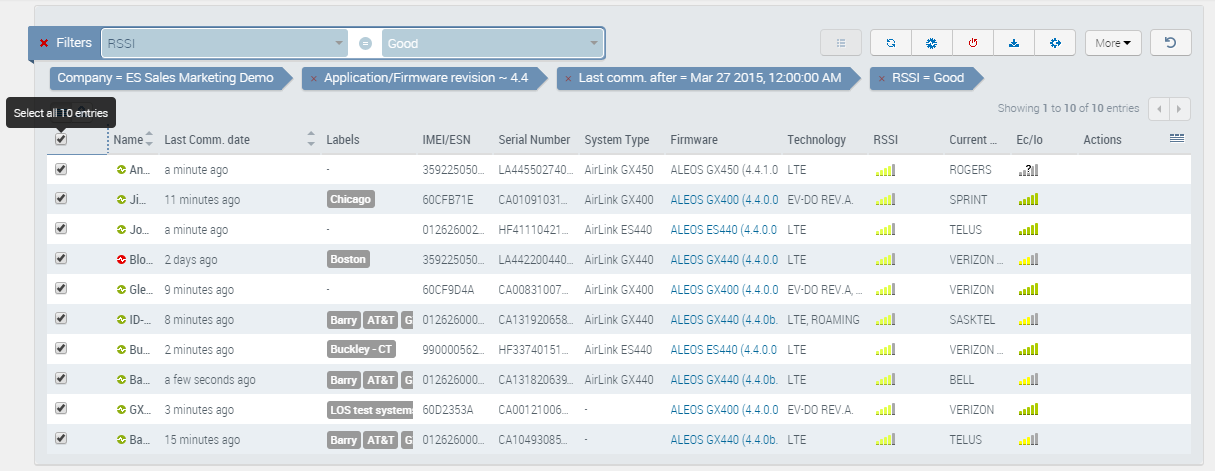
The filtered list can be saved in a group of systems using a label:
- Select all
- Select action More/Change labels
- Add the label for the new group
Or directly used to perform one of the device management operation.
General and Life Cycle
| Edit | Update existing systems in bulk | |
| Change Label | Add or remove labels. | |
| Export data history | Export a .csv file containing information in AirVantage for a single system. | |
| Export last data | Export a .csv file containing the last known information in AirVantage for multiple systems. |
Depending on the current state of your system, only the actions that can be triggered in that state will be available.
Module Management and Device Management
| Synchronize | Create an operation to Synchronize AirVantage with your systems. | |
| Configure Communication | Change the frequency your systems are communicating with AirVantage, and also define reports and frequency of these reports. | |
| Reboot | Reboot one or multiple systems. | |
| Upgrade Firmware | Upgrade one or multiple systems with a new firmware. | |
| Apply Template | Change the configuration of one or multiple systems applying a predefined template. | |
| Apply Workflow(s) | Apply several configuration operations in sequence to one or multiple systems. See How to configure systems using Apply Workflow(s)? for help. | |
| Retrieve > Device data | Retrieve a dataset from the device. See How to retrieve data from one or several systems? for help. | |
| Retrieve > System logs | Retrieve and then download logs from the device. | |
| Custom Command | Send a command to a system. Commands must be defined in one of the applications running in your system. | |
| Send SMS | Send a text SMS to one or multiple systems. A SMS gateway needs to be configured in your company. See How to configure an SMS account? for help. | |
| Wake Up | Send a wake-up message to your systems to trigger a communication with AirVantage. A SMS gateway needs to be configured in your company. See “How to configure an SMS account?” for help. The operation needs to be supported in the firmware of your device. | |
| Factory reset | Reset to factory default one or multiple systems. The operation needs to be supported in the firmware of your device. | |
| Install Application | Install or upgrade an embedded application on your systems. |
Depending on the capabilities of your firmware/application, only some of the operations listed above may be available.
Map View
You can switch to see your systems and status on the map from the system grid, and toggle from one to another.
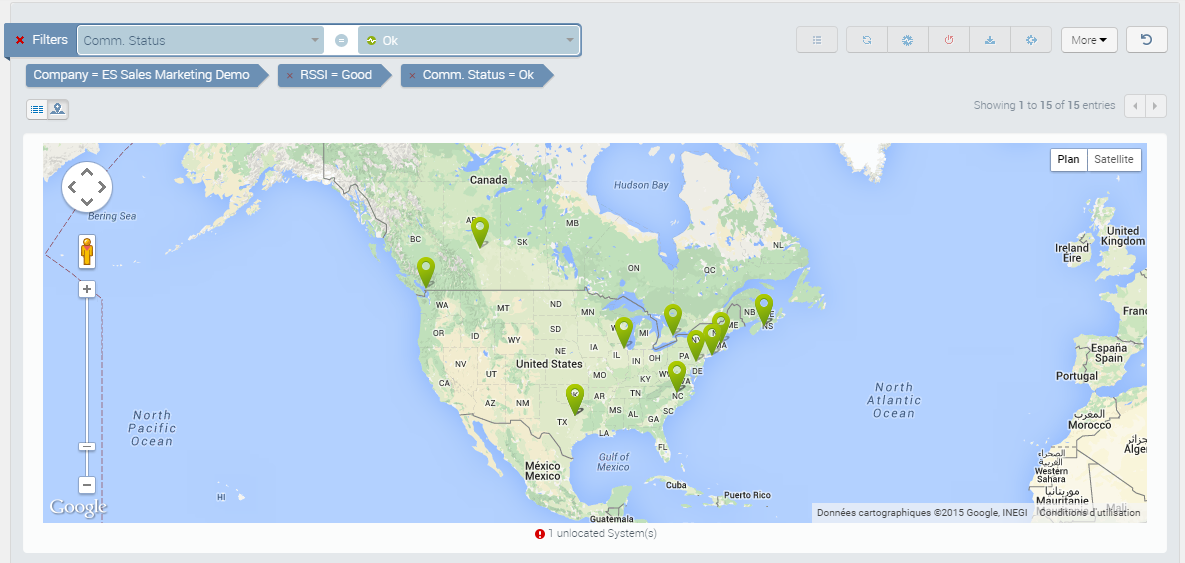
- In map view, you can still use the filters to drill down to a subset of your systems, the same way it can be done on grid view.
- By clicking on one specific system map marker icon, you will get details about this system and also direct link to launch a subset of operations on this system.
- The number of unlocated systems is reminded on the bottom of the map.
Device View
Most recent activity from the device is available from the system details screen. This page provides access into the device communications history as well as device configuration, direct access to AceManager by clicking on the IP address and other functions. check System View page for details.
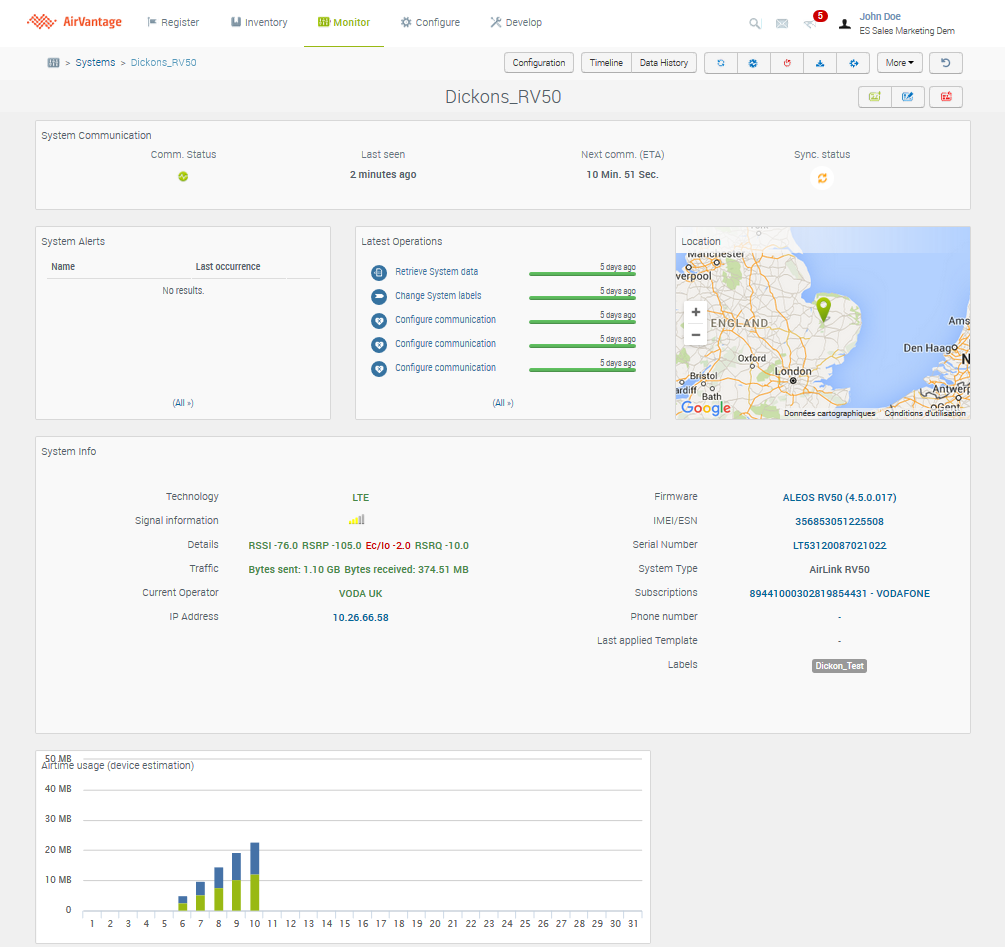
The details of a given system are accessed from the Systems list view clicking on the Details icon ![]() in the actions toolbar after selecting a system or directly in actions column of the system.
in the actions toolbar after selecting a system or directly in actions column of the system.
Over the air installation
Firmware upgrade
Sierra Wireless team is pushing new firmware packages on AirVantage so you can keep your fleet up to date with the latest features and security patches. AirVantage also provides different widgets showing which firmware versions are actually deployed on your systems and the upgrade status compared to latest released firmware.
There are two ways to launch a firmware upgrade.
- The simplest way to launch a firmware upgrade campaign for all devices with outdated firmware is from the Upgrade Status widget on the Start Page.
- To select one or more systems whose firmware needs upgrading, click on the Upgrade menu and select Systems.
Before upgrading, please ensure that the latest firmware is certified by your carrier. (You can find certification information for each firmware revision at Sierra Wireless Source
Fleet-based upgrade
The Upgrade Status widget on the Start Page Dashboard identifies systems in need of firmware upgrades, and lets you apply the latest build to all systems of a device type with a single click.
Where all devices of a given type are already up to date, a green status icon is shown on the widget. If some or all devices of a given type need updating, an amber or red status is shown.
Upgrade selected systems
Upgrade the firmware of one or a group of devices:
- Go to Monitor/Systems to view your fleet of systems in the grid as on the screenshot below
- Select the list of systems to be upgraded from the list
- Click on the Upgrade Firmware button

- Choose either the latest firmware of search for another specific firmware and click on Upgrade Firmware
- Monitor the progress, the status of the operation. In case of failure, apply retry without redoing the setup
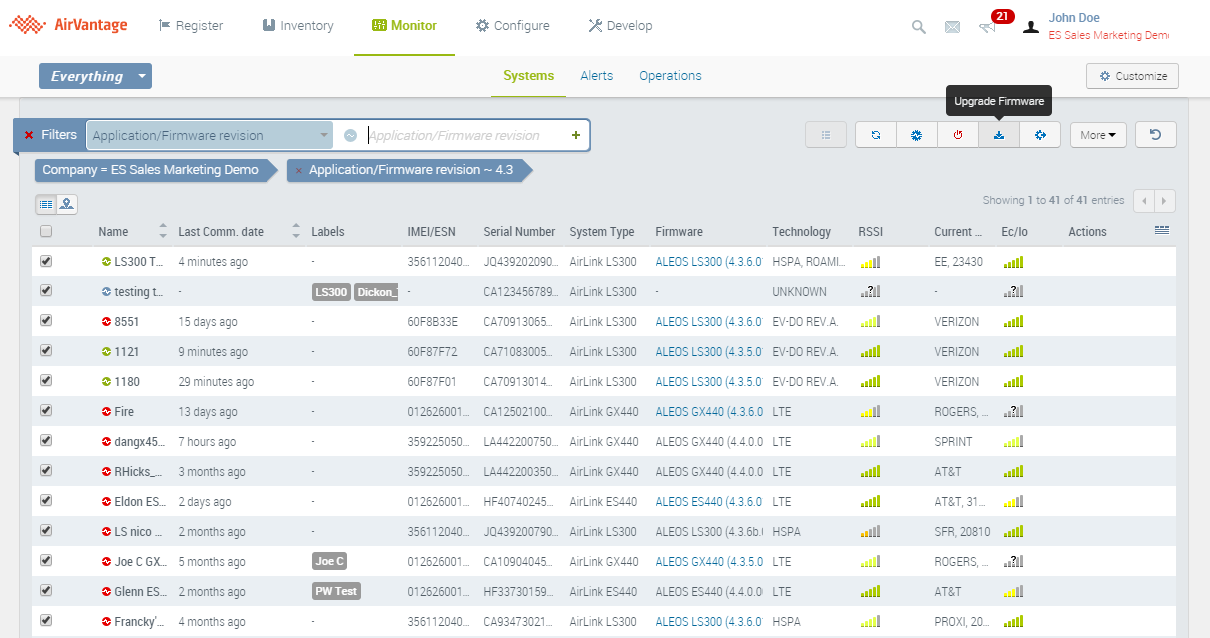
Application upgrade and install
Upgrade or install an embedded application on one or multiple devices.
- Embedded applications descriptors and update packages can be uploaded in AirVantage (see the Develop activity to release and publish a new application.) and as a consequence can be used to install the application or update an existing one on the compatible systems.
- Select the systems to upgrade from the list, click on Install application and choose the application to install. AirVantage will create an operation and execute the application installation over the air when the system will communicate.
- Monitor the progress, the status of the operation. In case of failure, apply retry without redoing the setup.
- AirVantage provides a widget showing which application versions are actually deployed on your systems.
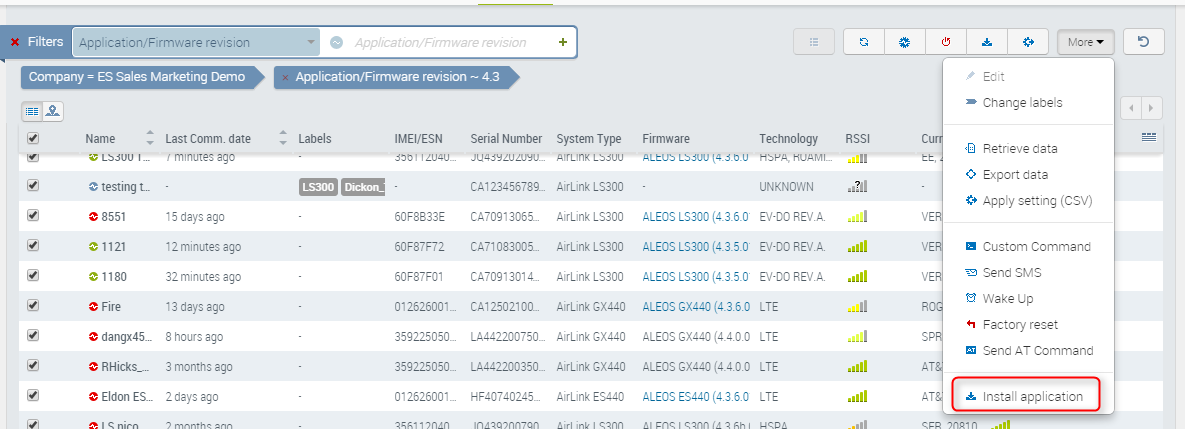
Alerts
AirVantage supports 2 types of alert:
- stateful alerts have a duration. These alert rules have a status that is raised as long as the conditions are met, and is cleared when the conditions are not met anymore (example: alert rule on communication status error, or on usage consumption over specific threshold). They contribute to the system’s alert state.
- events (or stateless alerts) are one shot non lasting alerts. They are usually generated by rules using the CHANGE or EXISTS operators (example: alert rule on system state changes). Events or stateless alerts are generated each time the rules conditions are met. Due to their ephemeral characteristc, they don’t impact the system’s alert state.
Identify systems in alert
Each system has got an alert state: a system can either be in alert  or not in alert ‘-’.
or not in alert ‘-’.
A system in alert has at least one alert rule for which an alert is currently raised on the system. As soon as the previous alert criteria is no longer met, meaning that the system goes back to expected behavior, its alert state will go back to ‘not in alert’.
If a system is in alert state due to several alerts being raised at the same time, its alert state will be cleared only once all rule violations have been fixed.
You can easily identify systems in alert in the grid of systems using the column “alert state” and “alert state change date”.
- Alert state is showing whether a system is currently in alert or not. A system in alert can be in alert due to one or more alert rules being fulfilled.
- Alert state change date informs you when the system became in alert, or back to normal. This column is not displayed by default, but can be added.
You can use the filtering capabilities with the alert state criteria to display only systems that have at least one alert currently raised.

Check Alerts
The loudspeaker with a red counter on the top banner displays the number of currently raised alarms on your fleet, with one different entry per system or offer and per alert rule. It appears as soon as you are logged in AirVantage.
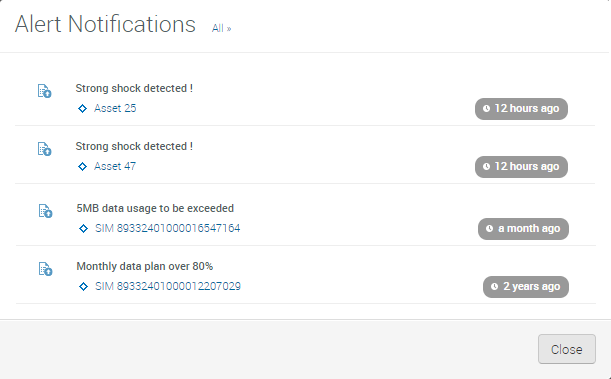
The Monitor > Current Alerts section is displaying all alerts currently raised on your systems and offers. Consequently, only stateful alerts currently raised are displayed in this screen. The list can be filtered by Alert rule name, type of target (system or offer) and also on the specific system or offer.
Alert rules are created in the Configure activity: Alert section .
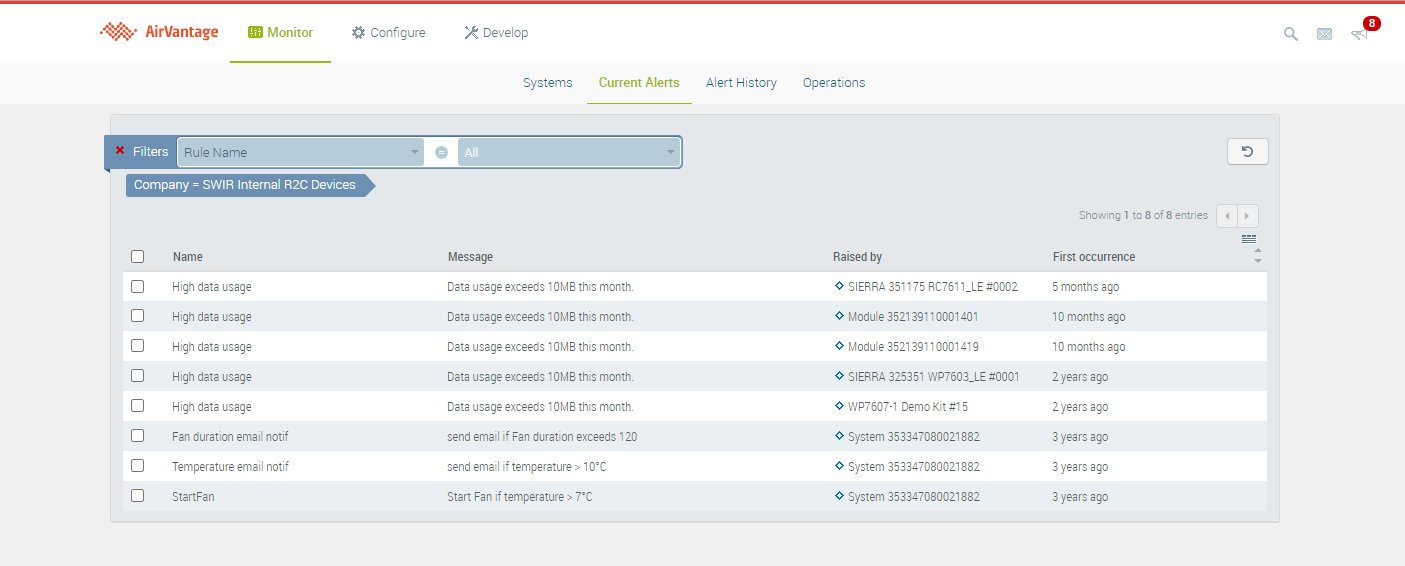
Finally you can click on an alert to show the details:
- related to the rules
- related to the conditions which raised the alert.
Analyze Alerts
The Monitor > Alert History section is displaying the alert history of your systems (events and for stateful alerts, when they have been raised and cleared). The list can be filtered by Alert rule name, target system, target offer, or a given period of time. In a single click, you can access to the rule, the system details, the systems with targeted offer, and the system’s timeline to analyze the system(s) behavior.
Alert rules are created in the Configure activity: Alert section .
Alert notifications
You set the alert once, and will get noticed when the alert is raised, and then when the alert is over and the system working back the expected way.
Configure devices over-the-air
Mass configuration change
For mass configuration, templates can be created or modified starting from an existing device or from scratch. You can find how to create a new template in the Configure pages.
Track which template has been successfully applied to each system
- A widget tracks the percentage (%) of systems per applied configuration template
- The systems list shows the last applied Template name to each. It can be used to filter the list.
Configure different value per device
Configuring your systems, you may be required to specify a different value for each. This is the case for names, identifiers, passwords, or unique configuration parameters like static IP address.

AirVantage provides a way to apply this mass configuration change. The individual settings are loaded from a file (.csv format). The systems can be identified using one among:
- Name
- Serial Number or IMEI
- ICCID/ESN or IMSI
- IP address
Apply Workflows: apply multiple operations to multiple devices
You can create complex sequences of operations to be applied to systems in a given order, similar to Preconfiguration during registration. Apply Workflow(s) allows you to reconfigure devices that are already registered.
Click Apply Workflow(s) ( ![]() ). On the Apply Workflow(s) screen you can then drag-and-drop actions in the desired order. AirVantage executes the selected actions in the order you have chosen. See How to configure systems using Apply Workflow(s)?
for more information.
). On the Apply Workflow(s) screen you can then drag-and-drop actions in the desired order. AirVantage executes the selected actions in the order you have chosen. See How to configure systems using Apply Workflow(s)?
for more information.
You can apply workflows only to systems of the same device type and firmware.
How-Tos
This section provides you with helpful procedures for common tasks.
